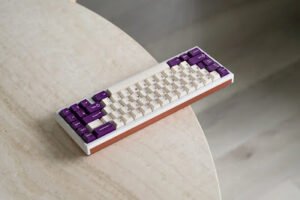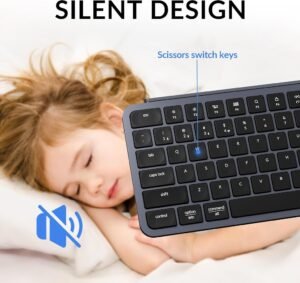My Dream Keyboard Features
Lately, I’ve been torn about replacing my keyboard—part of me wants a new one, but another part is hesitant. I’ve been wasting hours watching YouTube reviews, only to think, “This isn’t it,” or “That’s not great either.”
If money were no object, I could just buy something and figure it out later. But I’m stuck because I’m not even sure why I want to upgrade or what features I’m looking for.
So, as usual, I’m writing to untangle this confusion.
My Current Keyboard Is Wearing Out
The main reason I’m thinking about a new keyboard is that my current one is starting to show its age. I’m using a super compact ELECOM Wireless Bluetooth Keyboard, which cost about $29.99. Honestly, I’ve been really happy with it—it’s been great for the price. But after a year, the keys and top plate are starting to peel.
Some people obsess over key feel, buying multiple keyboards and customizing keycaps, but I’m not like that. For me, a keyboard just needs to work for typing. That’s why all my keyboards are budget-friendly.
That said, my “one year” of use isn’t typical. As a blogger, I write around 4,000 words every three days, so I’m probably much harder on keyboards than most people. Even so, the peeling feels a bit premature. I guess that’s what you get with $29.99—budget paint quality.
At that price, though, I could just buy another one. Replacing it every year feels reasonable for a consumable item. But since I’m thinking about a change, I want to explore other options. Hence, this post.
 |
| ELECOM Wireless Bluetooth Keyboard (Amazon : $29.99) |
What I Love About My Current Keyboard
Let’s recap why I like this keyboard so much. Here are its key strengths:
- Ordinary, no-fuss typing feel: The key feel isn’t quirky or unique. Despite its small size, it maintains a standard 19mm key pitch, making it super straightforward to use. Even with my larger hands, I can type comfortably, and switching to a laptop keyboard feels seamless because the sizing is identical. This “ordinariness” is a big deal—it means I can use anyone’s keyboard without feeling out of place.
- Incredibly thin: This is a huge plus. It’s thinner than most people would expect, slipping easily into a bag without taking up space. It’s been a dream for travel.
- Light (290g) yet stable: Conventional wisdom says keyboards need some weight for stability during typing, and I agree. But at just 290g, this one is surprisingly stable. The high-quality rubber pads on the bottom keep it from sliding, even when I’m typing aggressively.
This balance of lightness, thinness, ordinariness, and stability for $29.99 is rare. It’s a near-perfect package.
An Ergonomic Keyboard
While I think my current keyboard is almost perfect, I’m curious about alternatives—especially ergonomic ones.
Now that I’m in my late 40s, I’m starting to feel aches and pains. I suspect my typing posture might be part of the problem. Standard keyboards force my arms inward in an unnatural way. I haven’t had wrist pain from typing yet, but I’ve had similar issues with mouse use, so I’m worried it’s only a matter of time.
A split or ergonomic keyboard could reduce strain before it becomes a problem. Since I spend long hours at my desk, posture matters.
A Trackball Keyboard
 |
| image sorce : bastardkeyboard |
Going a step further, I’ve noticed some buzz around keyboards with built-in trackballs. I’m wondering if they’d be worth trying.
A trackball keyboard with ergonomic design could reduce physical strain and make blogging more efficient. Staying in the same posture for too long can wreck your body, so I’d love to preempt that with a keyboard upgrade.
But I’m concerned about finger fatigue: While trackballs reduce arm movement, they can strain your fingers. I’ve used a small (34mm) trackball before and switched to a larger (55mm) one because the smaller size was too taxing. Even with ergonomic design, finger fatigue might be unavoidable.
Custom Keyboards Are Too Complicated
 |
| image sorce : alexotos |
I’m intrigued by ergonomic and trackball keyboards, but custom keyboards feel overwhelming. They involve buying parts, assembling, and sometimes soldering—way too complex for a beginner. Plus, most are wired, and going wireless requires even more effort. The barrier to entry is just too high.
Even if I managed to build one, I wouldn’t recommend it to others. For me, gadgets should be accessible and easy to adopt. Blogging about something only a few can replicate feels pointless.
So, I’m sticking to off-the-shelf options and aiming to write posts that anyone can follow. Custom keyboards are a hard pass for now.
Logitech MX Keys Mini Is Heavy and Expensive
 |
| Logitech MX Keys Mini |
Setting custom keyboards aside, I considered a premium thin keyboard like the Logitech MX Keys Mini.
It’s a high-end compact keyboard with backlighting and great key feel, loved by many. But it weighs 400g and costs $160—steep for what it offers.
Honestly, I don’t need backlighting since I don’t look at the keys while typing. Instead of adding bells and whistles, I’d rather they cut the price by $50. Plus, 400g is 100g heavier than my current keyboard. Paying $160 for something heavier doesn’t feel like an upgrade. Pass.
 |
| Logitech MX Keys Mini Minimalist Wireless Illuminated Keyboard, Compact, Bluetooth, Backlit, USB-C, Compatible with Apple macOS, iOS, Windows, Linux, Android, Metal Build – Graphite (Amazon : $98.90) |
Keychron B1 Pro Is Affordable and High-Performing
 |
| Keychron B1 Pro Ultra-Slim |
The MX Keys Mini felt like a letdown, but then I found the Keychron B1 Pro, which seemed to address my gripes.
It looks similar to the MX Keys Mini, minus the backlight, and costs just $70—a $90 savings. It also offers great customization, like swappable key layouts. For a moment, I thought, “This is it!”
But here’s the thing: I don’t really need customization. I’m already happy with my current keyboard. And at 400g, the B1 Pro is still 100g heavier. Paying $70 for a heavier keyboard doesn’t feel like a win. Another pass.
 |
| Keychron B1 Pro Ultra-Slim ZMK/Launcher Wireless Bluetooth 2.4 GHz/Wired Connection Keyboard for Mac Windows Linux – Gray (Amazon : $39.99) |
Mechanical Keyboard?
 |
| Happy Hacking Keyboard Studio (Wireless, Bluetooth, Wired, USB, Silent, Mac, Windows, Charcoal, Printed) (Amazon : $339.41) |
Now I’m stuck. I might just buy the same keyboard again—it’s satisfying enough. But that feels like settling.
No other thin keyboard seems to surpass my current experience, and custom keyboards are too daunting. Replacing it with something similar feels uninspiring.
So, I’m starting to consider mechanical keyboards. I’ve never really used one before.
Mechanical keyboards don’t offer unique functionality, but their switches create distinct typing sounds, which has built them a loyal fanbase. They’d definitely feel different, and I’m curious if the “typing is fun” hype is real or just exaggerated.
Plus, I found models around 400g—not too heavy, not too light. They seem like a reasonable middle ground for a keyboard upgrade.
Mechanical Keyboards Are Big and Bulky
That said, mechanical keyboards have drawbacks. Their structure makes them less portable and thicker, which could strain my wrists.
They take up more space in a bag, and I’d rather not buy a wrist rest just to make one work—that feels like putting the cart before the horse.
Of course, this is just speculation. They might be fine, or even open new possibilities. You don’t know until you try, so I’m warming up to the idea of experimenting.
Considering a 60% or 40% Mechanical Keyboard
After all this back-and-forth, I’ve decided to give mechanical keyboards a shot.
Now I’m debating which model to get. A 60% keyboard (no function row) would free up desk space, while a 40% keyboard (no number row, too) would be even more portable.
This feels like a meaningful change, not just swapping one keyboard for a similar one.
Wish There Were Thin, Split Keyboards
This whole process has been tough because the keyboard market feels stagnant. So many brands, so many models—but they’re all kind of the same.
Key pitch, key feel, or weight might differ slightly, but the experience is largely identical. Keyboards are a mature product, so innovation has slowed. That’s not inherently bad, but it pushes people toward the endless rabbit hole of custom builds. With 3D printers becoming more common, that hole is getting deeper.
Still, custom keyboards have inspiring ideas—like split designs or trackball integration—that manufacturers are surely noticing.
I wish companies would move faster to create ergonomic, split, off-the-shelf keyboards for those of us who don’t want to dive into customization. A thin, split keyboard would be a dream.
What kind of keyboard do you use? Are you thinking about making a switch too?

